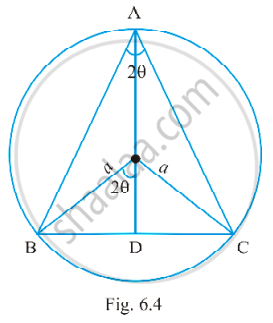Advertisements
Advertisements
प्रश्न
An isosceles triangle of vertical angle 2θ is inscribed in a circle of radius a. Show that the area of triangle is maximum when θ = `pi/6`
उत्तर

Let ABC be an isosceles triangle inscribed in the circle with radius a such that AB = AC.
AD = AO + OD = a + a cos2θ and BC = 2BD = 2a sin2θ (see fig. 16.4)
Therefore, area of the triangle ABC
i.e. ∆ = `1/2` BC . AD
= `1/2 2"a" sin2theta * ("a" + "a" cos2theta)`
= a2sin2θ (1 + cos2θ)
⇒ ∆ = `"a"^2sin2theta + 1/2 "a"^2 sin4theta`
Therefore, `("d"∆)/("d"theta)` = 2a2cos2θ + 2a2cos4θ
= 2a2(cos2θ + cos4θ)
`("d"∆)/("d"theta)` = cos2θ = –cos4θ = cos (π – 4θ)
Therefore, 2θ = π – 4θ
⇒ θ = `pi/6`
`("d"^2∆)/("d"theta)` = 2a2 (–2sin2θ – 4sin4θ) < 0 `("at" theta = pi/6)`.
Therefore, Area of triangle is maximum when θ = `pi/6`.
APPEARS IN
संबंधित प्रश्न
A cylindrical tank of radius 10 m is being filled with wheat at the rate of 314 cubic metre per hour. Then the depth of the wheat is increasing at the rate of ______.
f (x) = [x] for −1 ≤ x ≤ 1, where [x] denotes the greatest integer not exceeding x Discuss the applicability of Rolle's theorem for the following function on the indicated intervals ?
Verify Rolle's theorem for the following function on the indicated interval f(x) = x2 − 4x + 3 on [1, 3] ?
Verify Rolle's theorem for the following function on the indicated interval f (x) = (x2 − 1) (x − 2) on [−1, 2] ?
Verify Rolle's theorem for each of the following function on the indicated interval f (x) = cos 2 (x − π/4) on [0, π/2] ?
Verify Rolle's theorem for the following function on the indicated interval f(x) = ex sin x on [0, π] ?
Verify Rolle's theorem for the following function on the indicated interval f(x) = sin x + cos x on [0, π/2] ?
Verify Rolle's theorem for the following function on the indicated interval f(x) = x2 − 5x + 4 on [1, 4] ?
Examine if Rolle's theorem is applicable to any one of the following functions.
(i) f (x) = [x] for x ∈ [5, 9]
(ii) f (x) = [x] for x ∈ [−2, 2]
Can you say something about the converse of Rolle's Theorem from these functions?
Verify Lagrange's mean value theorem for the following function on the indicated intervals. find a point 'c' in the indicated interval as stated by the Lagrange's mean value theorem f(x) = x(x + 4)2 on [0, 4] ?
Verify Lagrange's mean value theorem for the following function on the indicated intervals. find a point 'c' in the indicated interval as stated by the Lagrange's mean value theorem \[f\left( x \right) = \sqrt{x^2 - 4} \text { on }[2, 4]\] ?
Verify Lagrange's mean value theorem for the following function on the indicated intervals. find a point 'c' in the indicated interval as stated by the Lagrange's mean value theorem f(x) = x3 − 5x2 − 3x on [1, 3] ?
Discuss the applicability of Lagrange's mean value theorem for the function
f(x) = | x | on [−1, 1] ?
Verify the hypothesis and conclusion of Lagrange's man value theorem for the function
f(x) = \[\frac{1}{4x - 1},\] 1≤ x ≤ 4 ?
Find a point on the curve y = x2 + x, where the tangent is parallel to the chord joining (0, 0) and (1, 2) ?
Find the value of c prescribed by Lagrange's mean value theorem for the function \[f\left( x \right) = \sqrt{x^2 - 4}\] defined on [2, 3] ?
If 4a + 2b + c = 0, then the equation 3ax2 + 2bx + c = 0 has at least one real root lying in the interval
If from Lagrange's mean value theorem, we have \[f' \left( x_1 \right) = \frac{f' \left( b \right) - f \left( a \right)}{b - a}, \text { then }\]
The value of c in Rolle's theorem when
f (x) = 2x3 − 5x2 − 4x + 3, x ∈ [1/3, 3] is
If f (x) = ex sin x in [0, π], then c in Rolle's theorem is
Find the points on the curve x2 + y2 − 2x − 3 = 0 at which the tangents are parallel to the x-axis ?
Find the maximum and minimum values of f(x) = secx + log cos2x, 0 < x < 2π
The least value of the function f(x) = `"a"x + "b"/x` (where a > 0, b > 0, x > 0) is ______.
The least value of the function f(x) = 2 cos x + x in the closed interval `[0, π/2]` is:
It is given that at x = 1, the function x4 - 62x2 + ax + 9 attains its maximum value on the interval [0, 2]. Find the value of a.
Let y = `f(x)` be the equation of a curve. Then the equation of tangent at (xo, yo) is :-
